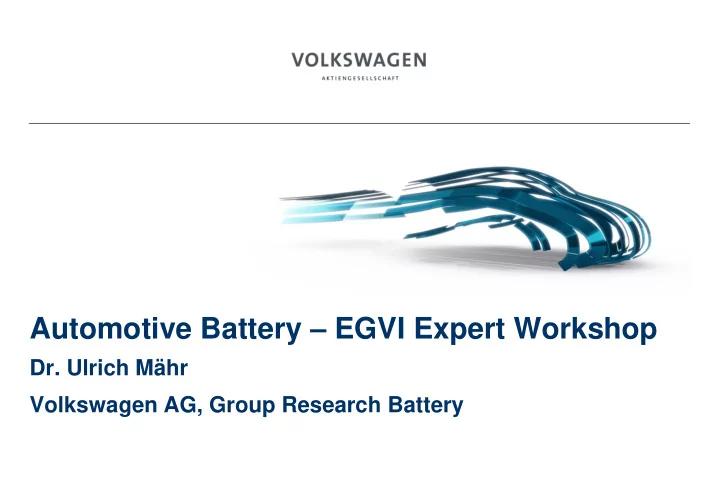

Automotive Battery – EGVI Expert Workshop Dr. Ulrich Mähr Volkswagen AG, Group Research Battery
Spectrum of new technologies for electric vehicles Infotainment Remote-steering / online services Heating Cooling Electrical brake power assist Traction battery and E-Motor and transmission battery managment Power electronics High voltage lines Cross-linking of components 2
Battery activities Volkswagen Group Research Li-ion batteries gen. 1 and 2 Gen 1: • Benchmark (energy and power, safety) • Analytics • Aging models Gen 2: • New materials, new cell types After Li-ion technologies • Li – sulfur • Li – oxygen Air cathode before and after discharge 3
Battery requirements for automotive applications Safety failure, accident, abuse, maintainance, comfort, reliability Costs profitability, Durability market acceptance cycles, lifetime recycling Power Energy electrical driving range, driving power, availability of comfort devices performance, charging time and infrastructure dynamics 4
Battery requirements for automotive applications Safety failure, accident, abuse, maintainance, comfort, reliability Costs profitability, Durability market acceptance cycles, lifetime recycling Power Energy electrical driving range, driving power, availability of comfort devices performance, charging time and infrastructure dynamics 5
Requirements for the cell: Hazard Level ≤ 4 Hazard Description Level 0 No effect Passive protection 1 devices activated 2 Defect / damage 3 Leakage 4 Venting 5 Fire or flame 6 Rupture 7 Explosion 6
Safety of Li-Ion technology Challenges • Used materials are sufficient safe, for improvement of life time and energy density also new safe materials have to be developed • Today safety is ensured by Acceleration [g] large efforts on system level Simulation of a rear-crash time [ms] • Research Further development of protective mechanisms (cell, module, system) • necessity Development of intrinsically safe materials 7
Lithium-plating and dendrite growth Intact area Damages on cell level during applicationrare but normal use • Short cut of anode and cathode by Lithium dendrites • Closed pores in the separator • Melting and recoagulation of the polymer Damaged area Molten and recoagulated fibre Separator 8
Battery requirements for automotive applications Safety failure, accident, abuse, maintainance, comfort, reliability Costs profitability, Durability market acceptance cycles, lifetime recycling Power Energy electrical driving range, driving power, availability of comfort devices performance, charging time and infrastructure dynamics 9
Life time of Lithium-Ion cells Challenges • Consideration of special ambient conditions Temperature (e.g. South Africa, Northern Sweden) Driving strategy (current, Depth of discharge, SOC, etc.) • Reliable durability prognosis is needed Laboratory for cell and ( 10 …15 years) battery testing • Combination of aging effects in the highly complex (VW Gorup Research) system of a Li-ion cell • Research Enhanced life time by materials research • necessity Development of prediction models for aging behaviour 10
Aging effects in lithium-ion cells Influencing parameters for Relative capacity [%] aging of Li-ion cells • Temperature • Time • Voltage (SOC) • Current, power • Charge- and discharge Relative capacity [%] levels Cycle number • Anode, cathode material • Electrolyte, additives • Cell type (pouch prismatic, cylindrical) • … Cycle number 11
Power capability at low temperatures Status / Challenges Typical behaviour of a Li-Ion cell Power Minimum requirement EV • Temperature requirements of automotive applications differ from consumer electronics: Consumer electronics: 0°C to 50°C Automotive requirement: -30°C to 60°C -30°C 23°C 60°C • Physics of electrolyte/solvent systems is Temperature limiting factor (cristallization) Schematic graph: abrupt power decrease of known Li-ion cells at low temperatures. Research Considerable expansion of operating temperatures by novel necessity electrolytes 12
Aging model Application Frequency of … Cell type (pouch, prism., cyl.) Cell chemistry Voltage (SOC) Voltage (SOC) Charge and discharge levels Charge and discharge levels Time Recovery time Temperature Temperature Current, power Power / currents 100 6k Energy / Power 80 5k 4k Count 60 3k rate 40 2k 20 1k Verification 0 0 0 100 200 -80 -60 -40 -20 0 20 40 Cycle number P_Batt [kW] • Reliable life time prediction in real vehicle operation on basis of Target laboratory measurements and simple technical operation data 13
Thank you! 14
Recommend
More recommend